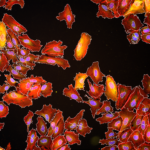Lien vers Pubmed [PMID] – 15332304
C. R. Biol. 2004 Jun;327(6):523-31
Deciphering how Listeria monocytogenes exploits the host cell machinery to invade mammalian cells during infection isa key issue for the understanding how this food-borne pathogen causes a pleiotropic disease ranging from gastro-enteritis to meningitis and abortions. Using multidisciplinary approaches, essentially combining bacterial genetics and cell biology, we have identified two bacterial proteins critical for entry into target cells, InlA and InlB. Their cellular ligands have been also identified: InlA interacts with the adhesion molecule E-cadherin, while InlB interacts with the receptor for the globular head of the complement factor Clq (gClq-R), with the hepatocyte growth factor receptor (c-Met) and with glycosaminoglycans(including heparan sulphate). The dynamic interaction between these cellular receptors and the actin cytoskeleton is currently under investigation. Several intracellular molecules have been recognized as key effectors for Listeria entry into target cells,including catenins (implicated in the connection of E-cadherin to actin) and the actin depolymerising factor/cofilin (involved in the rearrangement of the cytoskeleton in the InlB-dependent internalisation pathway). At the organism level, species specificity has been discovered concerning the interaction between InlA and E-cadherin, leading to the generation of transgenic mice expressing the human E-cadherin, in which the critical role of InlA in the crossing of the intestinal barrier has been clearly determined. Listeria appears as an instrumental model for addressing critical questions concerning both the complex process of bacterial pathogenesis and also fundamental molecular processes, such as phagocytosis.



